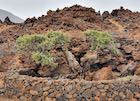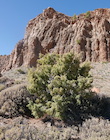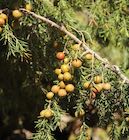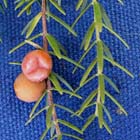Juniperus cedrus
Webb et Berthelot 1847
Common names
Canary Islands juniper; cedro Canario [Spanish].
Taxonomic notes
Section Juniperus, within which it shares a clade with J. oxycedrus and J. macrocarpa (Adams 2014). Syn. J. webbii Carr. 1855. Type, Canary Islands, P.B. Webb s.n., holotype FI.
Description
Trees previously recorded to 30 m (Dallimore et al. 1967), or shrub at high altitudes. Bark orange-brown, peeling in coarse vertical strings. Branches level, upcurved toward tips, with pendulous branchlets. Leaves in decussate whorls of three, subulate to acicular, 1-2 cm, green to glaucous on back, single narrow white stomatal bands either side of the midrib on the inner face. Dioecious, with male and female cones on different trees. Mature seed cones globose, 8-12 mm diameter, green ripening orange-red c. 18 months after pollination; with 1(2) whorls of 3 scales; seeds 3. (Frankis 1991, 1992).
Closely related to J. oxycedrus, from which it differs in the larger tree size, more regular branching and often glaucous leaves. Also closely related to J. brevifolia of the Azores, which has shorter and even more glaucous leaves.
Distribution and Ecology
Canary Islands: La Palma and Tenerife, at up to 2300 m elevation. Zone 9 (cold hardiness limit between -6.6°C and -1.1°C) (Bannister and Neuner 2001).
Currently listed by the IUCN as "Endangered" due to small area of occupancy (29 km²) and a very small population, with ca. 600 mature trees in 5 subpopulations distributed across five islands: Gran Canaria (n =12), Gomera (n = 100), La Palma (n = 250), Tenerife (n = 200) and Madeira (n = ca 40). These subpopulations are severely fragmented and reproductively isolated from each other. Regeneration in some subpopulations is poor or absent, possibly due to reduced seed set, the decline of avian dispersers, and the effects of grazing. In some locations fires have led to the loss of mature individuals. These factors contribute to continuing decline in the quality of habitat and number of mature individuals (Rumeu Ruiz et al. 2011).
Remarkable Specimens
The largest surviving wild trees are on the cliffs of La Caldera de Taburiente National Park on La Palma island (Dallimore et al. 1967), but I do not have any details.
"El Patriarcha" (photo at right) is a female tree on Tenerife thought to be 1,050 years old on the basis of a radiocarbon date derived from a sample of decayed wood from near the center of the tree (García-Cervigón et al. 2019). This research triggered further study of old trees, and Sangüesa-Barreda et al. (2022), also using radiocarbon dating, report the discovery of two more trees over 1,000 years old, one being a female tree estimated at 1,481 years, and the other a male estimated at 1,236 years. This age is exceeded in four other Juniperus species. The researchers attempted to collect samples for dendrochronological evaluation, but few trees yielded a record of more than 200 years, and none exceeded 550 years. There is still some concern whether these radiocarbon dates are in fact accurate; the researchers do not discuss the accuracy of the technique for tree age estimation, but work with olive trees (famous for putative great age) has shown that there can be significant problems with radiocarbon-based tree age estimates (Ehrlich et al. 2017).
Ethnobotany
The very valuable timber was extensively harvested in the first 500 years of Spanish occupation of the Islands; the species is now commercially extinct but replanting is in progress (Ashmole and Ashmole 1989). As a highly attractive species, it well deserves increased planting as an ornamental in areas of suitably mild climate, but is still seldom seen except in larger arboreta and botanical gardens.
Observations
Wild trees / large shrubs are easiest to see in Las Cañadas National Park, Tenerife, at La Fortaleza, a cliff on the NE part of the caldera wall of the dormant Teide volcano, an easy 4 km walk NW on a good path from the bus stop at El Portillo, the entrance to Las Cañadas NP (Ashmole and Ashmole 1989; Frankis 1991, 1992). This is a high altitude treeline population at 2100 m, with short glaucous leaves and small cones; some similar young trees are planted at 2080 m at the café at El Portillo (Frankis 1991, 1992). A plantation at Aguamansa, above Puerto de la Cruz at 1100 m altitude, planted c.1950, shows the potential of this species in the northern cloud belt; already about 15 m tall (a very fast growth rate for a Juniper) in 1991, they have telegraph-pole straight trunks to about 15-20 cm dbh, longer leaves to 2 cm and large (12 mm) cones (Frankis 1991).
Remarks
The epithet is a Latinized form of the local common name, cedro.
Citations
Adams, Robert P. 2014. Junipers of the World: The Genus Juniperus. Fourth edition. Trafford Publishing.
Ashmole, M. and P. Ashmole 1989. Natural history excursions in Tenerife. Peebles: Kidston Mill Press.
Ehrlich, Y., Regev, L., Kerem, Z., and Boaretto, E. 2017. Radiocarbon dating of an olive tree cross-section: new insights on growth patterns and implications for age estimation of olive trees. Frontiers in Plant Science 8. Available from https://www.frontiersin.org/articles/10.3389/fpls.2017.01918, accessed 2022.12.22.
Frankis, M.P. 1991.04. Field notes, Tenerife.
Frankis, M.P. 1992. Conifers of Tenerife. Conifer Society of Australia Newsletter 11: 5-7.
García-Cervigón, A. I., M. García-Hidalgo, J. L. Martín-Esquivel, V. Rozas, G. Sangüesa-Barreda, and J. M. Olano. 2019. The Patriarch: a Canary Islands juniper that has survived human pressure and volcanic activity for a millennium. Ecology 100(10):1–4.
Rumeu Ruiz, B., M. de Sequeira, M. Elliot, and M. Gardner. 2011. Juniperus cedrus (errata version published in 2017). The IUCN Red List of Threatened Species 2011: e.T30327A101032366. https://www.iucnredlist.org/species/30327/101032366, accessed on 2022.12.22.
Sangüesa-Barreda, G., García-Cervigón, A.I., García-Hidalgo, M., Rozas, V., Martín-Esquivel, J.L., Martín-Carbajal, J., Martínez, R., and Olano, J.M. 2022. Vertical cliffs harbor millennia-old junipers in the Canary Islands. Ecology 103(4): e3633. doi:10.1002/ecy.3633.
This page initially authored by M.P. Frankis, 1999.03.
See also
Elwes and Henry 1906-1913 at the Biodiversity Heritage Library. This series of volumes, privately printed, provides some of the most engaging descriptions of conifers ever published. Although they only treat species cultivated in the U.K. and Ireland, and the taxonomy is a bit dated, still these accounts are thorough, treating such topics as species description, range, varieties, exceptionally old or tall specimens, remarkable trees, and cultivation. Despite being over a century old, they are generally accurate, and are illustrated with some remarkable photographs and lithographs.
Farjon (2005) provides a detailed account, with illustrations.
Threatened Conifers of the World.





